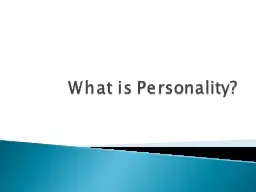

The set of psychological traits and mechanisms within the individual that are organized and relatively enduring and that influence his or her interactions with and adaptations to the intrapsychic ID: 277142
Download Presentation The PPT/PDF document "What is Personality?" is the property of its rightful owner. Permission is granted to download and print the materials on this web site for personal, non-commercial use only, and to display it on your personal computer provided you do not modify the materials and that you retain all copyright notices contained in the materials. By downloading content from our website, you accept the terms of this agreement.
Slide1
What is Personality? Slide2
The set of psychological traits and mechanisms within the individual that are organized and relatively enduring and that influence his or her interactions with, and adaptations to, the
intrapsychic
, physical, and social environments.
DefinitionSlide3
Characteristics that describe ways in which people are
different
from each other. Traits also define ways in which people are similar
to each other.
Finally, they describe the average tendencies of a person.
Psychological traitsSlide4
How many traits are there?
How are the traits organized?
What are the origins of traits?What are the correlations and consequences of traits?
Four research questions about traitsSlide5
They help describe
people.
They help explain behavior.
They help
predict future behavior.
Why are psychological traits useful?Slide6
They are organized and not simply a random collection of elements. Traits are linked to each other systematically.
They’re relatively enduring over time and are
somewhat consistent across situations.
The idea of consistency across situations has a long history of debate, but most personality psychologists now believe people are relatively consistent.
Difference between states and traits—for instance, anger is a state but hot-tempered is a trait.
More about traitsSlide7
Perceptions—how we interpret an environment
Selection
—how we choose our friends, careers, hobbies, etc. (How we use our free time is especially a reflection of our personalities.)
Evocations
—reactions we produce in others, often unintentionallyManipulations—the ways in which we intentionally try to influence others
Four components of person-environment interactionsSlide8
Our personalities help us adapt to the environment—accomplish goals, cope, and deal with the problems we face.
Psychologists’ knowledge of the adaptive function of personality is currently limited.
Adaption to the environment includes both
physical
and social
environment.
Social environment includes things such as our need for belongingness, love, and esteem.
Adaptations to the EnvironmentSlide9
Human nature
Need to belong
Capacity for loveIndividual and Group Differences
Variation in need to belong (individual difference)
Men more physically aggressive than women (group difference)
Individual Uniqueness
Person X’s unique way of expressing love
Person Y’s unique way of expressing aggression
Three Levels of AnalysisSlide10
A debate in the field: Should individuals be studied
nomethetically
or idiographically?
Nomothetic
research involves groups of people—requires samples of subjects
Usually applied to individual and group difference research
Idiographic
research involves single subjects to try to observe general principles that are manifest over a single life over time.
The term “idiographic” literally means “the description of one.”
Case studies/psychological biographies of one person
Nomothetic
vs. Idiographic ResearchSlide11
Grand theories vs. contemporary research
Stated another way, the gap between human nature level of analysis (“grand theories”) vs. group and individual differences (“contemporary research”)
Most textbooks in Personality focus on grand theories.
This gap has not yet been successfully bridged.
A Fissure in the FieldSlide12
Dispositional
How people differ from each other (traits)
Biological
Genetics, psychophysiology, and evolutionIntrapsychic
The role of the unconscious; research on motives (many of which are unconscious)
Cognitive-experiential
Conscious thoughts, beliefs, feelings, and desires; past vs. future selves, self-esteem
Social and Cultural
How different cultures display different personalities; how our personalities affect our social lives
Adjustment
How personality helps us cope and adapt to our lives; how personality is related to health
Six Domains of KnowledgeSlide13
A good theory fulfills three purposes:
Serves as a guide for researchers
Organizes known findingsPredicts behavior and psychological phenomena that have not yet been studied.
Theories differ from beliefs, such as astrology, because they can be tested by systematic observations that can be repeated by others and yield similar conclusions.
What makes a good theory?